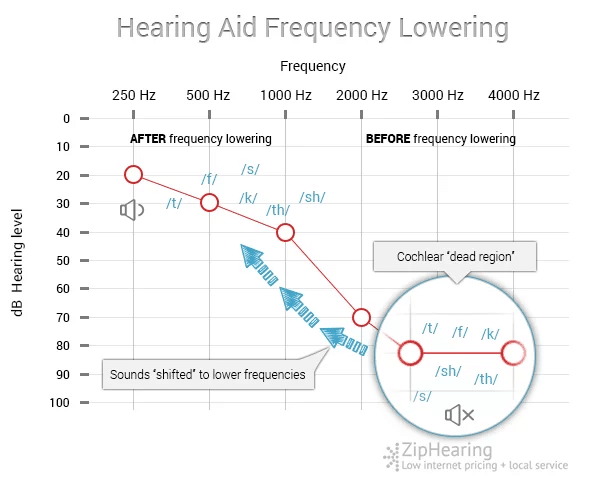Frequency Lowering in Hearing Aids
If you have a hearing loss, there is a good chance the majority of your loss is in the high frequencies.
With this type of a hearing loss, it is typically very difficult to hear words clearly and it often sounds like people are mumbling.
If you've already had a hearing test, your hearing provider may have gone over your results and explained why this is the case.
In short, the most important parts of speech for understanding are high frequency sounds- we're talking about consonants such as /s/, /k/, /th/- the sounds that give words their clarity.
When your high frequency hearing is impaired, these sounds don't come through clearly, so it's the job of hearing aids to amplify these sounds for you.
Most of the time, hearing aids do a very good job at bringing these hard-to-hear consonants back for you, so speech can be heard clearly again.
But what about when your hearing in the high frequencies is really bad, with your audiogram scores being below ~75dB HL?
In cases like this, there are generally two things that your hearing provider can do for you:
Boost the high frequency gain as much as possible
If you have a hard time hearing high frequency sounds, the first and most common-sense approach is of course, to turn up the gain (or volume) of the hearing aid in the high frequencies.
However, with most hearing aids, when the gain in the high frequencies is turned up too loud, feedback (whistling) becomes a problem.
In order to reduce the whistling, the gain is then turned down, and you're essentially left with less than the ideal gain, but it's better than nothing so you just live with it.
Forget about the high frequencies altogether
Going back to the above point for a minute, let's assume that you boost the gain all the way up, and you have a great hearing aid that doesn't feedback.
This still may not be an ideal situation.
In fact, many times, this won't make sound any more clear, and will often distort it, and make comprehending speech even more difficult.
Usually this occurs when there is a cochlear dead region.
To avoid these problems of distortion, etc, your hearing provider will probably decide to apply no gain in the high frequencies, or only apply gain up to a certain point.
Neither of the above approaches are ideal
Both involve a compromise.
However, and surprisingly, many people with severe to profound high frequency hearing loss are satisfied with one of the above approaches.
But there is an additional approach, which is centered on a technology which has been around for decades, that is seeing somewhat of a resurgence due to the advances in the digital signal processing of today's hearing aids.
This technology is collectively referred to as "frequency lowering."
Frequency lowering, transposition, compression, & shifting
These four terms are often (incorrectly) used interchangeably when describing frequency lowering technology, but their goal is the same: to make inaudible high frequency sounds audible, by presenting them as low frequency sounds to the hearing aid wearer.
The way this is actually done, and the differences between each of the above four terms, is a bit more technical than I think most folks would like to get in to here.
At the risk of over-simplifying frequency lowering- this feature captures those high frequency sounds from your environment, and then lowers them, or changes them, into low frequency sounds.
If you're like most folks, your low frequencies are quite a bit better than your high frequencies, so the logic here is that if these originally high frequency sounds are presented through your hearing aid as low frequency sounds, then you'll have an easier time hearing them.
We made the image below to better illustrate what frequency lowering does.

The key component of the above chart, and the whole reason why frequency lowering is even a necessary feature of hearing aids, is the "cochlear dead region."
On our chart, this "dead region" is identified as below 70db HL.
Meaning, any amplification applied beyond this point will either be ineffective, or detrimental.
In reality, this dead region will vary from person to person, and some lucky folks may have no dead regions at all.
As you can see from the above chart, before frequency lowering, the consonants in the dead region are essentially "muted"- they can't be heard.
You can also see via the arrows, that those consonants in the dead region are essentially pushed into the lower frequencies, so they are audible.
Let's take a bird's chirp for example, which has a frequency of around 4000hz.
Based on how your hearing provider has programmed your hearing aids, the hearing aid would process this sound, realize its in a dead region, and then shift it to a lower frequency and output it at say, 1000hz for example, where you have a better chance of hearing it.
Now you might be asking yourself, "if the hearing aid is altering the original signal and outputting it at a different frequency, isn't it going to sound weird?"
The answer to this is, "it depends."
Many people will appreciate this feature right from the start, but many will go through an adjustment period as well.
The thing about frequency lowering is that it helps you hear sounds that you haven't heard in a really long time.
Some of these sounds, like /s/ for example, may sound so unusual at first that it sounds like everyone is talking with a lisp.
In fact, my experience with frequency lowering has been that often when I activate it for a customer that I think would benefit from it, they do not initially like it.
However, if a customer will stick with it for a few weeks, it is very rare that they ask me to turn the feature off, as it does improve audibility significantly.
There is no question that things sound unusual for a while, but most of the time the benefit of hearing those high frequency sounds outweighs the fact that they don't quite sound normal.
Which hearing aid brands offer frequency lowering?
There are several hearing aid manufacturers which offer this as a feature in their hearing aids.
If you're thinking this might be a valuable feature to have, you might want to visit some of the manufacturer websites and check out some literature on their products to find hearing aids that have frequency lowering.
Note, there is no downside to getting a hearing aid that has this feature, if you don't like it, it can be turned off with the click of a button.
Like most hearing aid features, all manufacturers have a different name for their frequency lowering technology, so I've provided a short list of the major hearing aid manufacturers that offer this feature, and what they respectively have named that feature.
- Phonak: SoundRecover
- Siemens: Frequency compression
- Widex: Audibility Extender
- Oticon: Speech Rescue
- Starkey: Spectral IQ
We welcome comments from hearing providers and patients alike who have something to add to the conversation! Please feel free to post your comments below.







Jeff Hall
Hi Rich, any hearing aid from a major manufacturer is going to have some sort of frequency shifting active at those frequencies or above: Oticon, Phonak, Signia, Widex, ReSound, Starkey, Unitron
Hi Rich, any hearing aid from a major manufacturer is going to have some sort of frequency shifting active at those frequencies or above: Oticon, Phonak, Signia, Widex, ReSound, Starkey, Unitron
Kent Brashear
I’m in my fourth pair of hearing aids and now I’m experiencing that vocal list. Everyone is now lisping. I’m about ready to ask for help. I’ve had these hearing aids for over one month. I still have trouble understanding speech. Sounds are louder and I misunderstand at a higher frequency.
I’m in my fourth pair of hearing aids and now I’m experiencing that vocal list. Everyone is now lisping. I’m about ready to ask for help. I’ve had these hearing aids for over one month. I still have trouble understanding speech. Sounds are louder and I misunderstand at a higher frequency.
Marianne
Hi Jeff, thank you for your blog. I recently had my Widex passion adjusted after going to a concert, that affected my right ear. I lost 10dB extra and entering the severe to profound hearing loss area. What my aud did is exactly what you described in the above article. The aid simply “copy and paste” the inaudable frequency to a lower area so it can be heard. Very affective. But music now sounds distorted. I no longer enjoy listening to music while it sounds like an off-tuned radio. I am a musician, very frustrating, but I can use a remote control for Widex passion, my aud suggests to lower all the terrible “ss” sounds I need in speech , so I can enjoy music again. Some Widex devices have a button to control the sound. For those who find the “sss” is unacceptable, give your brain a week or two to adjust. It will get better.
Wonderful to read you are helping people all over the world to understand the complexity of hearing. Greetings from the Netherlands. Marianne
Hi Jeff, thank you for your blog. I recently had my Widex passion adjusted after going to a concert, that affected my right ear. I lost 10dB extra and entering the severe to profound hearing loss area. What my aud did is exactly what you described in the above article. The aid simply “copy and paste” the inaudable frequency to a lower area so it can be heard. Very affective. But music now sounds distorted. I no longer enjoy listening to music while it sounds like an off-tuned radio. I am a musician, very frustrating, but I can use a remote control for Widex passion, my aud suggests to lower all the terrible “ss” sounds I need in speech , so I can enjoy music again. Some Widex devices have a button to control the sound. For those who find the “sss” is unacceptable, give your brain a week or two to adjust. It will get better.
Wonderful to read you are helping people all over the world to understand the complexity of hearing. Greetings from the Netherlands. Marianne